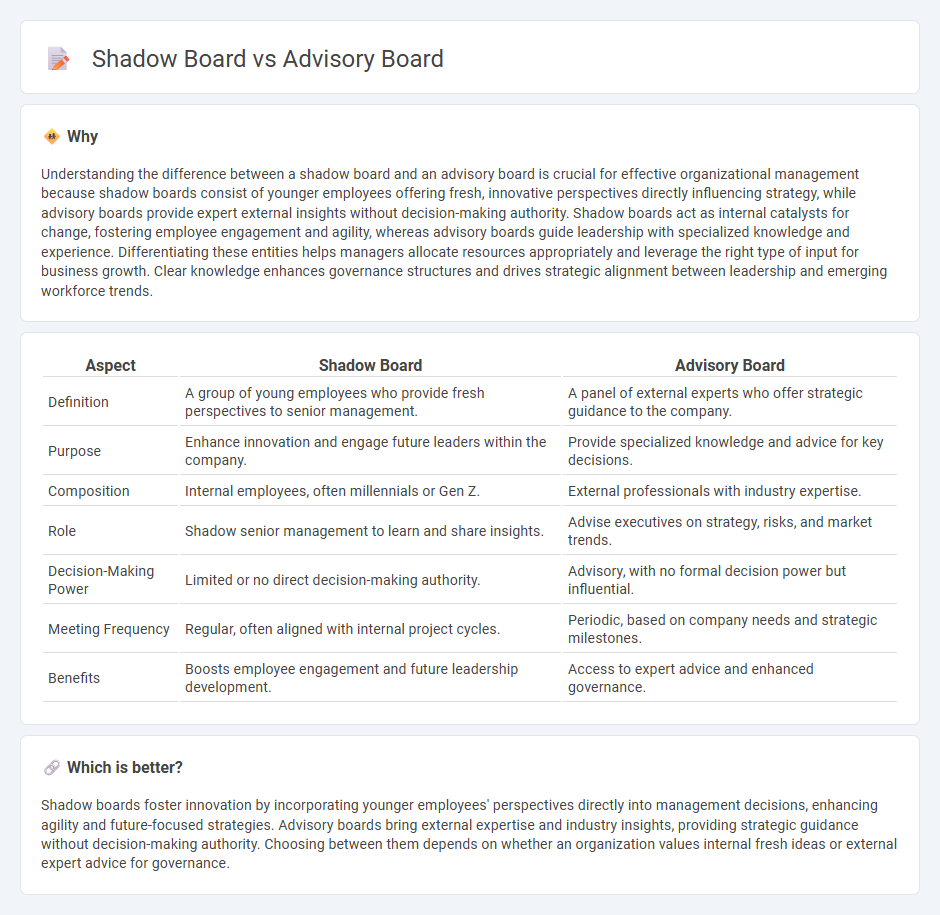
Shadow boards consist of younger employees who provide fresh, innovative perspectives to senior management, fostering agility and inclusivity in decision-making. Advisory boards are composed of external experts offering strategic guidance and industry insights to help organizations tackle complex challenges and capitalize on opportunities. Discover how integrating these boards can enhance your company's governance and innovation strategies.
Why it is important
Understanding the difference between a shadow board and an advisory board is crucial for effective organizational management because shadow boards consist of younger employees offering fresh, innovative perspectives directly influencing strategy, while advisory boards provide expert external insights without decision-making authority. Shadow boards act as internal catalysts for change, fostering employee engagement and agility, whereas advisory boards guide leadership with specialized knowledge and experience. Differentiating these entities helps managers allocate resources appropriately and leverage the right type of input for business growth. Clear knowledge enhances governance structures and drives strategic alignment between leadership and emerging workforce trends.
Comparison Table
| Aspect | Shadow Board | Advisory Board |
|---|---|---|
| Definition | A group of young employees who provide fresh perspectives to senior management. | A panel of external experts who offer strategic guidance to the company. |
| Purpose | Enhance innovation and engage future leaders within the company. | Provide specialized knowledge and advice for key decisions. |
| Composition | Internal employees, often millennials or Gen Z. | External professionals with industry expertise. |
| Role | Shadow senior management to learn and share insights. | Advise executives on strategy, risks, and market trends. |
| Decision-Making Power | Limited or no direct decision-making authority. | Advisory, with no formal decision power but influential. |
| Meeting Frequency | Regular, often aligned with internal project cycles. | Periodic, based on company needs and strategic milestones. |
| Benefits | Boosts employee engagement and future leadership development. | Access to expert advice and enhanced governance. |
Which is better?
Shadow boards foster innovation by incorporating younger employees' perspectives directly into management decisions, enhancing agility and future-focused strategies. Advisory boards bring external expertise and industry insights, providing strategic guidance without decision-making authority. Choosing between them depends on whether an organization values internal fresh ideas or external expert advice for governance.
Connection
Shadow boards function as a dynamic, youthful extension of traditional advisory boards by providing fresh perspectives and innovative ideas, thereby enhancing strategic decision-making. Advisory boards offer experienced, external expertise to guide management, while shadow boards engage emerging leaders within the organization to anticipate future challenges. Together, these boards create a comprehensive governance framework that balances seasoned insight with forward-looking creativity to optimize management effectiveness.
Key Terms
External expertise (Advisory board)
Advisory boards provide companies with external expertise by bringing in industry veterans, subject matter experts, and experienced professionals who offer strategic insights and objective guidance. These external advisors help businesses navigate complex challenges and identify new market opportunities through their specialized knowledge and broad networks. Explore how leveraging an advisory board can drive innovation and growth within your organization.
Next-generation leadership (Shadow board)
Shadow boards consist of next-generation leaders who provide fresh perspectives and innovative ideas directly to a company's executive team. Unlike advisory boards, which often include external experts offering strategic guidance, shadow boards empower younger employees to influence decision-making and drive organizational change. Explore the benefits and implementation strategies of shadow boards for fostering dynamic leadership growth.
Strategic guidance (both)
Advisory boards provide strategic guidance by offering expert insights and industry knowledge to support executive decision-making without direct authority. Shadow boards, composed mainly of younger employees, contribute fresh perspectives on strategy, fostering innovation and reflecting emerging market trends. Explore how both boards can enhance your company's strategic direction and leadership development.
Source and External Links
How to Structure an Advisory Board - This webpage provides guidance on structuring an advisory board, including key roles and responsibilities, and how such boards help organizations gain new insights and solve business problems.
Key Differences Between an Advisory Board and Board of Directors - This article highlights the differences between advisory boards and boards of directors, focusing on their roles, responsibilities, and decision-making authority.
What Are Nonprofit Advisory Boards? - This webpage explains the role of advisory boards in the context of nonprofits, how they are formed, and their function in providing specialized advice to the board of directors.
 dowidth.com
dowidth.com